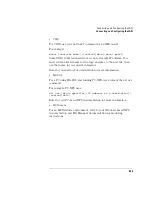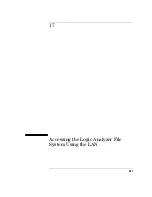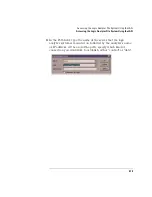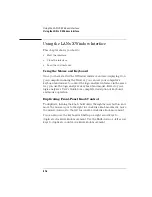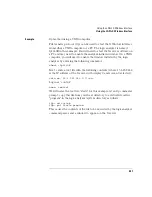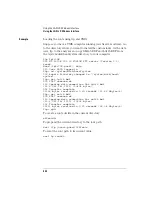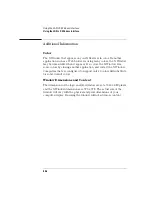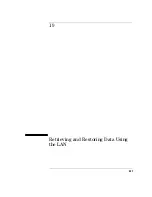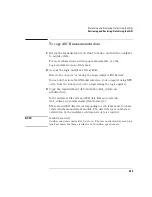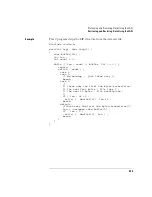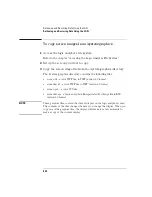
519
Using the LAN’s X Window Interface
Using the LAN’s X Window Interface
To start the interface from the computer
1
On your Xserver, enable analyzer-initiated windows.
Most Xserver packages have a security feature which stops unwanted
client-initiated windows from being displayed.
On computers running the UNIX operating system, you can enable
analyzer-initiated windows by entering the xhost command:
xhost +<analyzer IP address>
On computers that aren’t running the UNIX operating system, the
Xserver package documentation will explain its security features.
2
Send the XWIN ON programming command to the logic analyzer.
The syntax of the XWIN ON command is:
xwin on,"<Xserver IP address>:<display>.<screen>"
The IP (Internet Protocol) address is the address of the XWindows
server.
There are several methods for sending the XWIN ON command. The
easiest is using psuedo-telnet, but it can also be done using ftp or
writing to the NFS-mounted logic analyzer. See the following examples.
Example
NFS method using a UNIX computer
To enable windows to be initiated from the logic analyzer named
lp1660E, enter the following command on the computer running the
Xserver:
xhost +lp1660E
If you have NFS mounted the analyzer’s file system to a directory
named /logic on your computer whose IP address is 15.6.253.146 (and
is running the Xserver), enter the following command to start the
XWindow interface:
echo "xwin on,’15.6.253.146:0.0’" > /logic/system/
program
Summary of Contents for 1670E Series
Page 6: ...6 In This Book...
Page 26: ...26 Contents...
Page 27: ...27 Section 1 Logic Analyzer...
Page 28: ...28...
Page 29: ...29 1 Logic Analyzer Overview...
Page 39: ...39 2 Connecting Peripherals...
Page 49: ...49 3 Using the Logic Analyzer...
Page 72: ...72 Using the Logic Analyzer The Inverse Assembler...
Page 73: ...73 4 Using the Trigger Menu...
Page 101: ...101 5 Using the Oscilloscope...
Page 151: ...151 6 Using the Pattern Generator...
Page 199: ...199 7 Triggering Examples...
Page 237: ...237 8 File Management...
Page 249: ...249 9 Logic Analyzer Reference...
Page 360: ...360 Logic Analyzer Reference The Compare Menu...
Page 361: ...361 10 System Performance Analysis SPA Software...
Page 397: ...397 11 Logic Analyzer Concepts...
Page 430: ...430 Logic Analyzer Concepts The Analyzer Hardware Oscilloscope board theory Oscilloscope board...
Page 439: ...439 12 Troubleshooting the Logic Analyzer...
Page 455: ...455 13 Specifications...
Page 471: ...471 14 Operator s Service...
Page 479: ...479 Operator s Service Troubleshooting Troubleshooting Flowchart 2...
Page 491: ...491 Section 2 LAN...
Page 492: ...492...
Page 493: ...493 15 Introducing the LAN Interface...
Page 497: ...497 16 Connecting and Configuring the LAN...
Page 506: ...506 Connecting and Configuring the LAN Connecting and Configuring the LAN...
Page 507: ...507 17 Accessing the Logic Analyzer File System Using the LAN...
Page 515: ...515 18 Using the LAN s X Window Interface...
Page 527: ...527 19 Retrieving and Restoring Data Using the LAN...
Page 539: ...539 20 Programming the Logic Analyzer Using the LAN...
Page 546: ...546 Programming the Logic Analyzer Using the LAN Programming the Logic Analyzer Using the LAN...
Page 547: ...547 21 LAN Concepts...
Page 555: ...555 22 Troubleshooting the LAN Connection...
Page 580: ...580 Troubleshooting the LAN Connection Getting Service Support...
Page 581: ...581 Section 3 Symbol Utility...
Page 582: ...582...
Page 583: ...583 23 Symbol Utility Introduction...
Page 588: ...588 Symbol Utility Introduction Symbol Utility Introduction...
Page 589: ...589 24 Getting Started with the Symbol Utility...
Page 597: ...597 25 Using the Symbol Utility...
Page 609: ...609 26 Symbol Utility Features and Functions...

